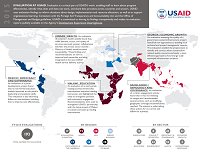Speeches Shim
USAID has made an ambitious commitment to rigorous and quality program evaluation – the systematic collection and analysis of information to improve effectiveness and inform decisions about current and future programming. USAID's Evaluation Policy demonstrates its commitment to the objectives laid out in the Foreign Aid Transparency and Accountability Act (signed into law July 2016). It also works in concert with existing Agency policies, strategies, and operational guidance, including those regarding project design, evaluation-related competencies of staff, performance monitoring, knowledge management, and research management.
Since the release of the Evaluation Policy, USAID has:
- Increased the number of evaluations commissioned each year to an average of about 200 per year, totaling more than 1,100 evaluations since 2011.
- Provided formal training in evaluation to more than 3,000 USAID staff.
- Improved the quality of evaluations by ensuring that planning happens in advance, using the best methods for answering a focused set of questions and encouraging that evaluations be conducted by external experts.
- Reported transparently on evaluation findings, particularly by sharing evaluation reports online at the Development Experience Clearinghouse.
- Used evaluation findings to inform project design, make mid-course corrections, increase knowledge and learning in specific sectors.
- Strengthened program monitoring so that evaluations can focus on a more complex set of questions beyond whether a project is meeting its targets.
In addition, USAID Administrator Mark Green recently designated the Director of the Office of Learning, Evaluation and Research, in the Bureau for Policy, Planning and Learning, to fulfill the functions of Agency Evaluation Officer. This new role will ensure compliance with the Foundations for Evidence-based Policy Making Act .
For a summary of USAID evaluations, including a regional and sector breakdown, please click on the appropriate year below.
FY 2017 Evaluation at USAID, FY 2017
|
FY 2016 Evaluation at USAID, FY 2016
|
FY 2015 Evaluation at USAID, FY 2015
|
Evaluation Policy Implementation
The reports below summarize evaluation requirements and practices at USAID before and after the Evaluation Policy, major accomplishments during the first five years of implementation, and priority activities to support policy implementation moving forward.
Evaluation Quality and Utilization
Relevant and high-quality evaluation is an important tool to track the progress, results and effectiveness of international development programs. Evaluation is used to systematically collect and analyze information to improve program effectiveness and inform decisions. Along with monitoring, evaluation contributes evidence to improve strategic planning, project design and resource decisions, and they are part of a greater body of knowledge and learning.
To better understand whether these and other efforts are working, the Bureau for Policy, Planning and Learning commissioned independent studies to examine evaluation quality (2013) and evaluation utilization (2016) at USAID. These two studies found there has been an increase in the quality and use of evaluations. The recommendations in these studies will inform ongoing evaluation improvement efforts.
- Meta-Evaluation of Quality and Coverage of USAID Evaluations
- Evaluation Utilization at USAID | Two Page Summary
For examples of how USAID has used evaluations to learn from and inform its work, please see the following case studies:
- Using Evidence to Adapt Education Programming
- Using Evaluation Results to Change Governmental Policy
- Looking Across Evaluations for Learning: Synthesizing Food Security Evaluations to Inform a Learning Agenda
- Using Evaluation to Revise Program Design
Learning
USAID intentionally embeds a strong emphasis on strategic collaboration, continuous learning and adaptive management throughout its programming.
USAID’s approach, known as Collaborating, Learning and Adapting (CLA) supports the achievement of development results by facilitating internal and external collaboration and ensuring new learning is used to adjust activities, projects and country strategies to be more effective in reaching their objectives.
For more information about how USAID approaches learning, please visit USAID's Learning Lab.
A list of learning agendas managed by USAID/ Washington Operating Units can be found here.
Monitoring, Evaluation and Learning Resources
USAID’s Monitoring, Evaluation and CLA toolkits complement USAID’s Program Cycle Operational Policy (ADS 201). These regularly updated toolkits curate the latest Program Cycle guidance, tools and templates for planning, managing, using and learning from monitoring and evaluation. They also include resources for USAID staff and partners on how to be more strategic and intentional when collaborating, learning and adapting throughout the Program Cycle.
A complete list of USAID’s publicly available evaluation reports, is available on the Development Experience Clearinghouse.

Comment
Make a general inquiry or suggest an improvement.